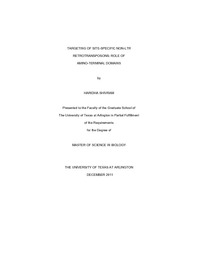
ATTENTION: The works hosted here are being migrated to a new repository that will consolidate resources, improve discoverability, and better show UTA's research impact on the global community. We will update authors as the migration progresses. Please see MavMatrix for more information.
Show simple item record
| dc.contributor.author | Shivram, Haridha | en_US |
| dc.date.accessioned | 2012-04-11T20:56:30Z | |
| dc.date.available | 2012-04-11T20:56:30Z | |
| dc.date.issued | 2012-04-11 | |
| dc.date.submitted | January 2011 | en_US |
| dc.identifier.other | DISS-11447 | en_US |
| dc.identifier.uri | http://hdl.handle.net/10106/9587 | |
| dc.description.abstract | Restriction-like endonuclease (RLE) bearing non-LTR retrotransposons are site-specificelements that integrate into the genome through target primed reverse transcription (TPRT). RLE-bearing elements have been used as a model system for investigating non-LTR retrotransposon integration. R2 elements target a specific site in the 28S rDNA gene. We previously demonstrated that the two major sub-classes of R2 (R2-A and R2-D) target the R2 insertion site in an opposing manner with regard to the pairing of known DNA binding domains and bound sequences―indicating that the A- and D-clades represent independently derived modes of targeting that site. Elements have been discovered that group phylogenetically with R2 but do not target the canonical R2 site. Here we extend our earlier studies to show that a separate R2-A clade element, which targets a site other than the canonical R2 site, does so by using the amino-terminal zinc fingers and Myb motifs. We further extend our targeting studies beyond R2 clade elements by investigating the ability of the amino-terminal zinc fingers from the nematode NeSL-1 element to target its integration site (This work was done by Dillon Cawley). Our data are consistent with the use of an amino-terminal DNA binding domain as one of the major targeting determinants used by RLE-bearing non-LTR retrotransposons to secure a protein subunit near the insertion site. This amino-terminal DNA binding domain can undergo modifications, allowing the element to target novel sites. The binding orientation of the amino- terminal domain relative to the insertion site is quite variable. | en_US |
| dc.description.sponsorship | Christensen, Shawn | en_US |
| dc.language.iso | en | en_US |
| dc.publisher | Biology | en_US |
| dc.title | Targeting Of Site-specific Non-LTR Retrotransposons: Role Of Amino-terminal Domains | en_US |
| dc.type | M.S. | en_US |
| dc.contributor.committeeChair | Christensen, Shawn | en_US |
| dc.degree.department | Biology | en_US |
| dc.degree.discipline | Biology | en_US |
| dc.degree.grantor | University of Texas at Arlington | en_US |
| dc.degree.level | masters | en_US |
| dc.degree.name | M.S. | en_US |
Files in this item
- Name:
- Shivram_uta_2502M_11447.pdf
- Size:
- 18.17Mb
- Format:
- PDF
This item appears in the following Collection(s)
Show simple item record


